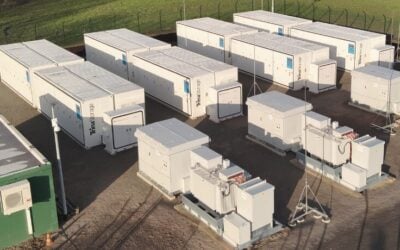An ‘electricity trading’ scheme to be launched by Reposit Power in Australia for residential energy storage system owners has been described by an analyst as “one of the most interesting examples” of software as a differentiator in the energy storage marketplace.
Sam Wilkinson, associate director of solar supply chain and energy storage at IHS, told PV Tech this week that Reposit Power’s ‘GridCredits’ scheme is “one of the most interesting examples that I have seen recently”, of software defining the purpose and use of energy storage systems. The scheme will allow energy storage system owners to exploit the disparity between peak and off-peak priced energy. Beginning with an initial six-unit trial, the programme could be rolled out later this year.
Following a recent webinar on energy storage in photovoltaics (PV), PV Tech asked Wilkinson how much of the value of energy storage is in the non-battery or generation aspects, taking software as an example. PV Tech also asked if there was more scope for product differentiation in software than there might be in batteries, for the most part.
Wilkinson said that at present, he saw software as a major product differentiator, and an area where some interesting and innovative work is taking place. As with others in the industry, Wilkinson said the business case for a storage system can be defined by the energy management system it is connected to, as much as by the generation source e.g. solar PV array or grid, or by the particular chemistry or sub-chemistry of the battery.
Try Premium for just $1
- Full premium access for the first month at only $1
- Converts to an annual rate after 30 days unless cancelled
- Cancel anytime during the trial period
Premium Benefits
- Expert industry analysis and interviews
- Digital access to PV Tech Power journal
- Exclusive event discounts
Or get the full Premium subscription right away
Or continue reading this article for free
“I certainly see software as a major area for differentiation at the moment,” Wilkinson said.
“Ultimately, in almost every case, the business model for storage relies on the technology being extremely accurate, intelligence and responsive. The software is also the owner or operator’s window into the system and could be a major factor in his decision of whether to buy storage, and which system to use.”
Software is growing increasingly important for energy storage and according to Sam Wilkinson of IHS, is still a major area for differentiation of storage systems and products. Image: SMA.
Wilkinson highlighted the example of Reposit Power, which PV Tech Storage covered in December, when the Australian Renewable Energy Association (ARENA) pledged to fund AUS$445,000 (US$346,000) of the project’s total AU$930,000 cost.
Then, the project had been the subject of a research note by IHS. In that note, IHS had described GridCredits as a “novel scheme in the residential energy storage sector”. Storage systems are sold through GridCredits for around AU$15,000 a unit and include 9.9kW system – translating into a 13.8kWh nameplate lithium battery with an effective energy output of 10kWh. Electronics company Magellan Power will supply the battery technology.
While the battery capacity is larger than usual for a residential system, IHS wrote, “the extra capacity is likely required in order to trade energy, rather than simply meeting personal consumption and storing excess PV energy” and called the system’s price, which equates to less than AUS$900 per kWh, as competitive. Also worth noting is that while the system does not have to be paired with a PV system, it is being marketed as such and is most likely to make economic sense in this instance.
IHS had pointed out that GridCredits has the potential to be “highly successful”, leveraging a growing residential market that it said installed 1.9GW of systems between 2012 and 2014. The research firm said that “this scheme will appeal mainly to customers who have already installed PV to help increase self-consumption”, especially with feed-in tariffs (FiTs) in Australia a diminishing proposition.
Reposit claims that “with a device no bigger than a fridge, you can turn your house into a mini power station”. The actual trading of energy is done automatically through the system’s all-important software, which determines prices, load, when best to sell and when best to self-consume. IHS also pointed out in its December research note that aggregating a large number of the systems could also allow GridCredits to be used to provide grid balancing services and infrastructure investment deferral, as well as to integrate greater penetration of solar on the grid.





